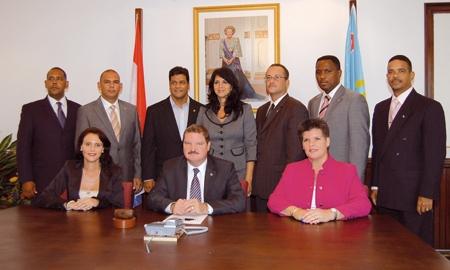The buzzwords today in Aruba are green, entrepreneurism, knowledge, sustainability, diversification and quality, all of which can be found throughout the country’s economic vision called ‘Green Gateway: a knowledge-driven, entrepreneurial economy’.
The result of an in-depth governmental study of Aruba’s human and natural resources, limited growth space, geopolitical situation as a member of the Dutch Kingdom, and external conditions (including fluctuations in the price of oil) led to the drafting of this strategic plan that embraces knowledge, long-term investment, quality growth and ecological responsibility. The Green Gateway also envisions a more diversified base for greater economic resilience.
A three-year strategy (2011-2013), the idea of Green Gateway symbolizes an innovative and competitive economy of free trade and enterprise, fair commerce, and corporate social responsibility, all in the context of Aruba’s uniquely distinct cultural, geopolitical and environmental assets.
The plan addresses national innovation, investment promotion, business growth and the empowerment of consumers. It is being spearheaded by the Ministry of Economic Affairs, which is, in parallel, simplifying the procedure for the establishment of new companies. With faster start-up times, more entrepreneurs could take part in the opportunities arising as a result of Green Gateway, through the public-private partnership (PPP) framework. Indeed, the government intends to increase the number of PPPs as it considers that they can contribute to a healthy economic landscape, synergizing the best of the public and private sectors.
Michelle Hooyboer-Winklaar, Minister of Economic Affairs, Social Affairs and Culture, believes that the responsibility for improving the quality of life on the island is no longer solely in the hands of either the government or private business. “The idea that projects which make a difference in the living standards of residents should be carried by either the public or private sector is really gone. It is something that we recognize needs to be done by both sectors, and there are so many formats to be able to tap into that, the first example being the Green Corridor,” she says.
The Green Corridor, a four-lane road linking Oranjestad and San Nicolas, is just one example of an infrastructure project intended to not only improve quality of life but also facilitate more economic activity. Other projects include the restoration of water towers, the relocation of the industrial harbor from Oranjestad to Barcadera, Ringweg 3 (a highway circumventing Oranjestad), general road repairs, and the renewal of the downtown area.
An essential component of Green Gateway, as its name suggests, is a focus on clean energies, and Aruba’s abundant wind, water and sun make it the ideal location to conduct research and testing of new technologies in the field of sustainable energy.
Aruba’s airport is also going green. Minister of Tourism, Transport and Labor Otmar Oduber says that a project to install additional solar panels will bring the amount of energy produced up to the same level as that of energy being used. “We would be the first 100% green airport in the Caribbean, producing 4.3 MW of energy,” says the Minister. “We have shown and the Prime Minister has shown that we are committed to ecotourism in Aruba, because we truly believe that tourism is more than just marketing and selling beautiful beaches. It is about diversification, ecotourism, green energy, culture, history and good infrastructure.”
“We must understand that a small island has limited resources. We need to maximize on what exists today.”
Michelle Hooyboer-Winklaar,
Minister of Economic Affairs, Social Affairs and Culture |
While alternative energy production and green technologies are excellent sources of economic diversification – one of the hallmarks of Green Gateway – tourism is and will most likely remain Aruba’s main money earner. Although Aruba does not necessarily intend to diversify away from this sector, it does plan to maximize possibilities.
Ms. Hooyboer-Winklaar explains: “It is really important that Aruba looks at the components of our economy and at where we can diversify further. When we talk about diversification, it often gives the impression that we are going to take away something from here and put it there – but that is not the case. We are looking at adding value to whatever we already have today; it is about improving the quality of tourists who come and looking at other economic activities that we can stimulate on this island.”
Other smaller pillars that she proposes to add to tourism are the growth of small and medium businesses (SMEs) in all sectors, stimulating entrepreneurship, and maximizing opportunities Aruba has in geographic and political terms.
It is in the tourism sector where Aruba’s formula of quality over quantity is most evident. “If you choose quantity, you continue to build and you grow your tourism sector. But at a certain point it is going to be impossible to build,” says Ms. Hooyboer-Winklaar. “We must understand that a small island has limited resources. We need to maximize on what exists today and a way of doing that is increasing the quality of tourists who come. In the long run, you are attracting tourists who will spend and will be aware and conscious of the impact of this island when they come here.”
The United States is the biggest source of tourists, yet a growing diversification of markets has helped the island nation avoid the worst of the financial crisis. Latin America, for example, increasingly sees Aruba as a tourist destination.
In delivering a more elevated experience for Arubans and visitors, alike, the country is creating what it is calling Bo Aruba, or ‘Your Aruba’. Greater diversification and economic stability, improved wellbeing, and cleaner land, air and water will combine to serve as an excellent calling card for Aruba in the region and beyond. Indeed, Green Gateway sees Aruba as a robust link between Latin America, the U.S. and the European Union for commerce, investments, and of course cultural exchanges.

0 COMMENTS